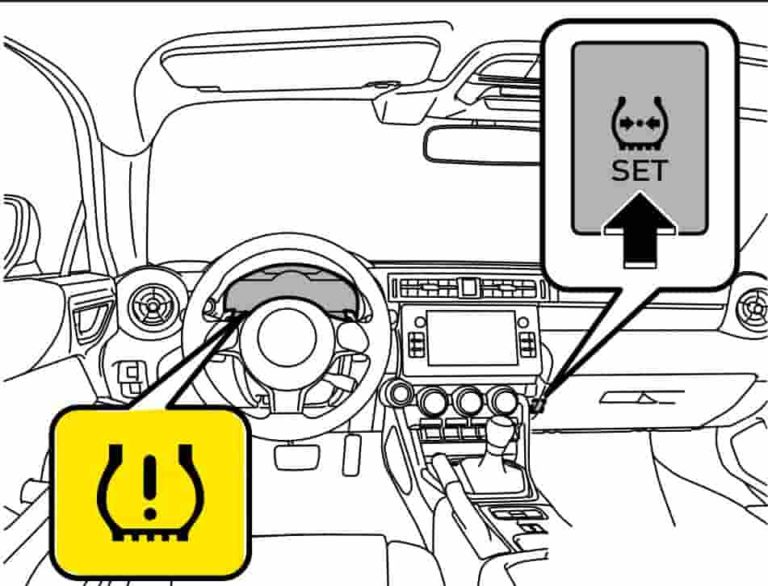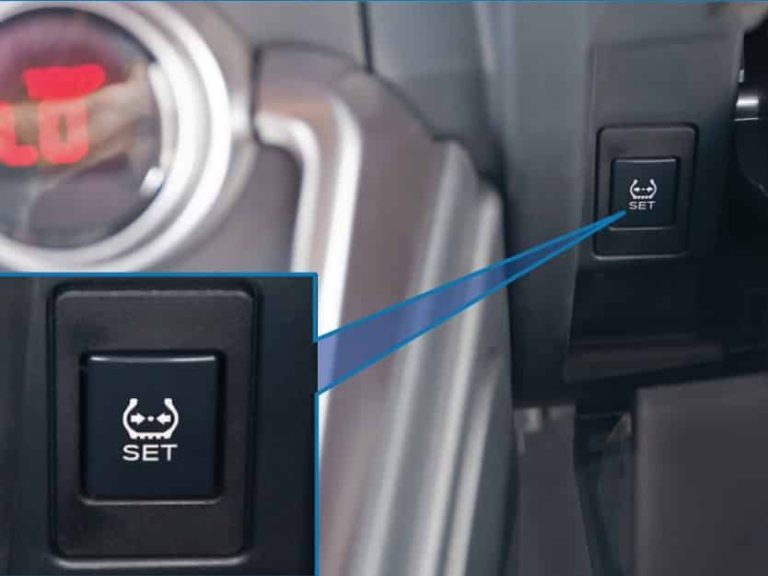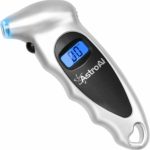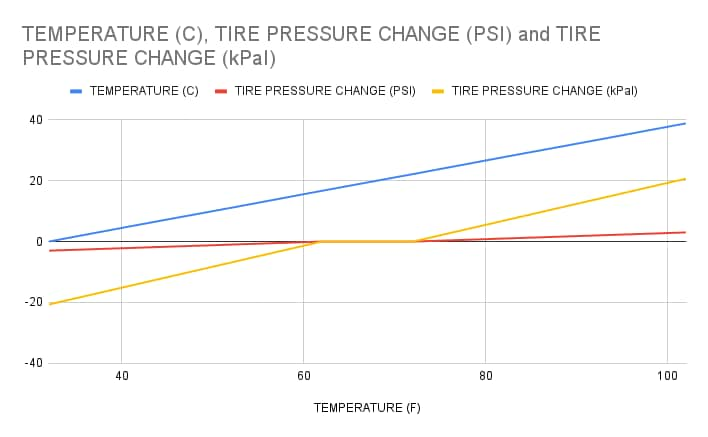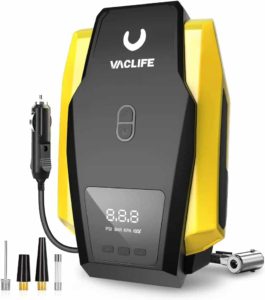What is the Subaru BRZ TPMS?
The tire pressure monitoring system (TPMS) in the Subaru BRZ is a built-in safety feature designed to alert the driver when tire pressure levels fall below the recommended range. It is an important tool for maintaining proper tire inflation, which can improve vehicle handling, decrease tire wear, and even increase fuel efficiency. When the TPMS detects that one or more of your tires is underinflated, a warning light will illuminate on the dashboard to let you know that your attention is required.
Subaru BRZ Tire Pressure Light Reset Procedure
Park the BRZ in a safe place and put the car in neutral. (the car has to be stopped for this to work)
Adjust your tire pressures to 35 Psi in the front and rear tires. Only adjust the air pressure when the tires are “cold”. (read more below on what this means)
Turn the ignition to the “ON” position. This means electricity on and engine off.
Press and hold the TPMS button located on the left of the glove box. (in some models the button may be in the glove box)
The tire light on your dashboard will blink slowly 3 times. (the yellow exclamation point)
Drive your BRZ for 5-10 minutes at speeds over 25 Mph.
If this procedure does not work, re-check to make sure all 4 tires are at exactly 35 Psi still, if they are, do the reset procedure again. If the pressure in any tire has decreased since adjusting them all to 35 Psi, you likely have some kind of leak. If your tire light is flashing every time you start your BRZ, read the section below on TPMS Malfunction.
One more option, if you followed all these steps and the light is still on (and you don’t have a leak), check your spare tire. Some Subaru’s (depending on the package you have) do have a full size spare with a pressure sensor in them. Make sure your spare tire has 60 Psi. Now drive the car again.
NOTE: If you’ve completed all of these steps and the tire light STILL won’t go out, There is only one of three things that can be the problem. Either have a faulty tire pressure sensor in one of your wheels OR you have a leak OR your receiver module (control unit) is not communicating with your sensors (this is the least of all likely and is rare).
2023 Subaru BRZ Tire Pressure
TIRE SIZE | FRONT PSI | REAR PSI |
215/45R17 | 35 | 35 |
215/40R18 | 35 | 35 |
SPARE TIRE | 60 | 60 |
How Does the Subaru BRZ TPMS Work?
The Tire Pressure Monitoring System (TPMS) in a Subaru BRZ operates using a combination of electronic and sensor technologies to detect and monitor the pressure inside each tire. Here is how it all works:
Sensors and Transmitters: Each wheel on your Subaru BRZ has a sensor located inside, attached to the end of each valve stem. These sensors measure the air pressure inside the tire. Along with pressure data, each sensor also has a unique identifier to differentiate between the four different wheels.
Data Transmission: These sensors are also equipped with radio frequency (RF) transmitters. If the tire pressure drops below the preset minimum level (usually 15%-25% below the recommended tire pressure), the sensor activates its RF transmitter and sends a coded signal wirelessly to the TPMS control module in the car. The code includes information about the tire’s pressure and the unique identifier of the sensor. (the identifier is just an ID number written on the back of each sensor)
Control Module and Processing: The TPMS control module, a microcomputer inside the vehicle, receives this signal. It decodes the data and determines which tire is underinflated based on the sensor’s unique identifier. (this is why it’s important to reset your tire system after a tire rotation)
Warning Indicator: If the control module confirms that the tire pressure is too low, it sends a signal to the car’s dashboard, illuminating the TPMS warning light. The Subaru BRZ will display which tire is low in yellow on your tire display screen.
Response: The driver is then expected to respond by checking the tire pressures manually and re-inflating the tires as necessary. Once the tire pressure is corrected and the vehicle is driven, the sensors will check the pressures again and, if back within the correct range, the TPMS control module will turn off the warning light. If it does not reset itself after correcting the pressure, follow the steps outlined above to reset the tire light.
Battery Monitoring: The sensors in the tires are powered by small built-in batteries, which have a limited life. When the battery level gets too low, this can also trigger the TPMS malfunction light. (The batteries look like basic wrist watch batteries and can last 5-10 years. When the batteries die, you must replace the entire sensor.)
What is the TPMS Malfunction Light?
The Subaru BRZ’s tire pressure monitoring system also has a malfunction indicator to alert you when something is wrong with the system itself. This indicator uses the same yellow exclamation point as the low tire pressure light. The difference is that, if there is a problem with the system, the light will flash for approximately one minute before staying on. This flashing or blinking will happen every time you start your car until the issue is resolved. When your tire light is flashing your BRZ will not be able to accurately measure tire pressure. To be clear, a blinking tire pressure light means there is an issue within the tire pressure monitoring system itself, rather than a tire pressure issue. This is usually due to a faulty pressure sensor in one of your tires (a dead or dying battery) or driving with the spare tire. (if the spare doesn’t have a sensor in it) To figure out which sensor is malfunctioning or faulty, use a TPMS diagnostic tool and scan each sensor for diagnostic information.
Why is My Tire Pressure Light On?
What Will Cause the TPMS to Not Work Properly?
Using non Subaru tire sizes.
Using non Subaru wheels.
If a window tint is installed, this can sometimes affect radio wave signals. (especially thick tints) Any electronic device that uses radio signals can interfere with the TPMS.
If there is lots of snow or ice on or around the tire valves.
If wheels without tire pressure sensors are installed on the car.
If the tire pressure is extremely high.
If new tire pressure sensors are installed without registering the new sensor IDs with the BRZ’s receiver module/ECU.
Driving with the spare tire on.
What Can Cause the Tire Light to Turn On?
Seasonal temperature changes: A drop in ambient temperature can cause tire pressure to decrease, triggering the warning light.
Tire puncture or leak: A sharp object or road debris like a nail or screw may puncture a tire, causing air loss which will of course activate the warning light.
Faulty tire pressure sensor: Damaged or malfunctioning sensors may provide inaccurate readings, resulting in a false alert. The only way to determine which sensor is faulty is to scan each sensor with a TPMS diagnostic tool.
Valve stem issues: A damaged or leaking valve stem can lead to gradual pressure loss and eventual activation of the tire pressure light. They make kits to replace the rubber gasket that usually goes bad.
Tire damage: Impact from potholes or hitting a curb can cause structural damage like tire bubbles, leading to pressure loss.
Sensor battery life: TPMS sensors are battery-powered, and over time, batteries die. (they usually last anywhere from 5-10 years) This will cause the tire pressure light to turn on. Again, you must use a diagnostic tool to determine which sensor is dead or dying.
Recent tire rotation or replacement: If the tires have been recently rotated or replaced, the TPMS may need recalibration to avoid false alerts. Sometimes the vehicle’s computer may think the front tires are in the rear and rear in the front after a rotation.
Wheel or rim issues: Damaged, corroded, or cracked wheels or rims can lead to air leaks and pressure loss. This is very common with low profile tires.
Altitude changes: Climbing or descending in elevation can affect tire pressure and trigger the TPMS warning. An additional 1.5 Psi per Km above sea level is required.
Natural pressure loss: Tires lose air pressure over time due to temperature changes and permeation. Tire dry-rot will happen to tires that sit.
Electrical problems or software issues within the car’s TPMS system. Occasionally the system may have a software update from Subaru.
Snow Tires: If you have a separate set of wheels/rims for snow tires, either swap over the sensors from your summer wheels or purchase a second set of 4 sensors for the second set of wheels/rims. If you are using one set of wheels for both sets of tires, do not worry about this.
What Happens When Tires are Underinflated or Overinflated?
Underinflation:
Decreased Fuel Efficiency: Underinflated tires can decrease the fuel efficiency of your vehicle because they cause increased rolling resistance, making the engine work harder.
Uneven Tire Wear: Tires that are underinflated often wear unevenly, particularly along the edges of the tire, reducing the lifespan of the tire.
Decreased Handling and Stability: Underinflated tires can negatively affect the car’s handling and stability, making it harder to steer, particularly at high speeds or in sharp turns. This is especially important in a high performance car like the BRZ.
Increased Risk of Tire Damage: Underinflated tires are more susceptible to damage such as flats or blowouts because they can’t properly distribute the weight of the vehicle.
Overinflation:
Uneven Tire Wear: Overinflated tires tend to wear unevenly as well, but in this case, the center of the tire tread tends to wear more quickly than the edges.
Decreased Traction: Overinflated tires can decrease the vehicle’s traction because a smaller portion of the tire’s surface area comes into contact with the road.
Increased Risk of Tire Damage: Overinflated tires are more susceptible to damage from road hazards like potholes or debris, and they’re also at a higher risk of a blowout due to increased tension within the tire. Overinflated tires are harder and easier to puncture by sharp objects like nails or screws.
Harsher Ride: Overinflation can result in a harsher, less comfortable ride because the tires are less able to absorb the impact from bumps or uneven road surfaces. This will also make the road noise inside the car louder.
How Does the Weather Affect Tire Pressure?
Weather plays a significant role in determining tire pressure, primarily due to the principle that air contracts when it’s cold and expands when it’s hot. During colder months or sudden drops in temperature, the air inside your tires will contract, causing the tire pressure to decrease. This can lead to underinflation and potentially triggering your vehicle’s TPMS warning light. Conversely, in hotter weather or after prolonged exposure to the sun the air inside the tires will expand. This will cause an increase in tire pressure and lead to overinflation. A general rule of thumb to keep in mind is that for every 10 degrees Fahrenheit change in temperature your tire pressure will fluctuate by about 1 Psi.
How to Adjust Tire Pressure
Get a high-quality tire gauge.
Make sure to check the tire pressure when the tires are cold. “Cold” means your vehicle has been sitting for at least three hours or driven less than 1 mile in the past 3 hours.
Take off the valve cap from the tire valve stem.
Push the tire gauge firmly onto the valve to measure the pressure.
Compare the pressure reading with the recommended pressure on the tire information label. 35 PSI in the front and rear tires in the BRZ.
If the pressure is lower than the recommended pressure, add air.
If the pressure is too high, let out some air by pressing the metal stem in the center of the tire valve. You can use any object like a screwdriver to do this. Be gentle.
Recheck the tire pressure with the gauge.
Don’t forget to put the valve caps back on to prevent leaks and keep dirt and moisture out.
When's the Best Time to Adjust Tire Pressure?
For the most accurate tire pressure reading on your Subaru BRZ, check it when the car hasn’t been driven for around 3 hours, such as first thing in the morning. This is known as “cold pressure”. Driving warms up your tires and makes the air inside them expand, which can give a higher, inaccurate reading. So, don’t pump air into your tires just after you’ve driven, or you might overfill them!
Conclusion
Keeping your Subaru BRZ’s tires at the correct pressure is critical for both safety and performance. Remember, the TPMS is your ally in maintaining optimal tire health, but it’s not a substitute for regular manual checks. Be mindful of factors like weather changes and driving habits that can influence tire pressure, and respond promptly to any TPMS alerts. Drive smart, drive safe! Everything in this article is applicable to all Subaru BRZ models and trims. Including, BRZ Premium and BRZ Limited.

